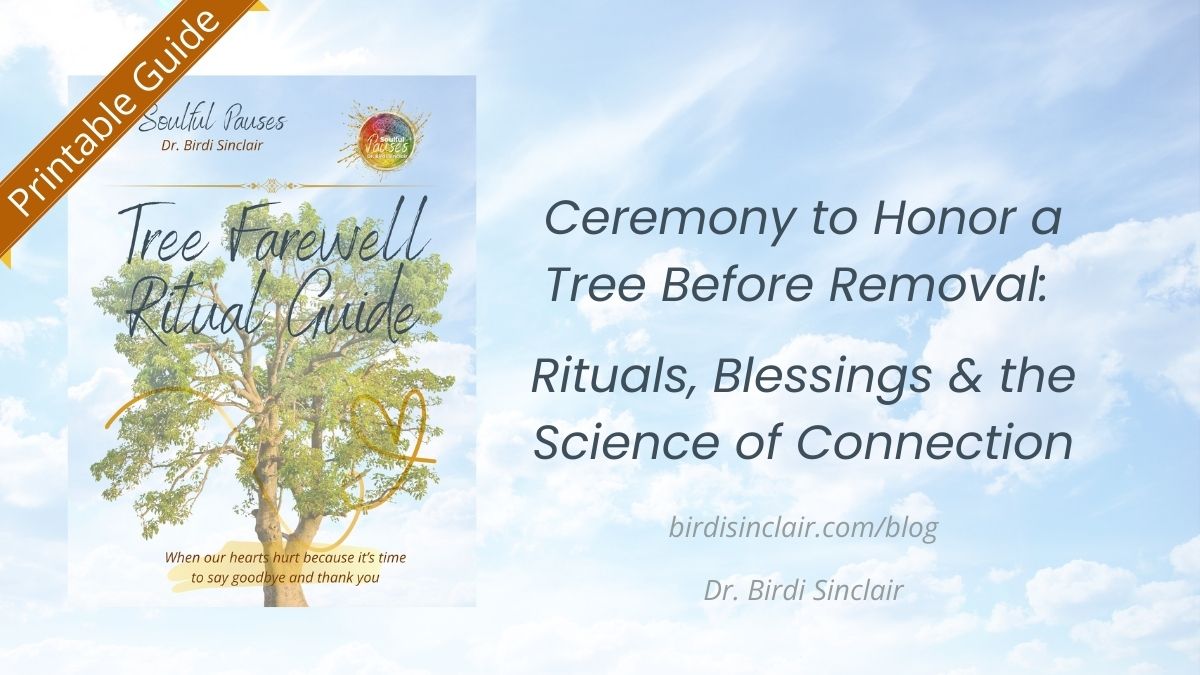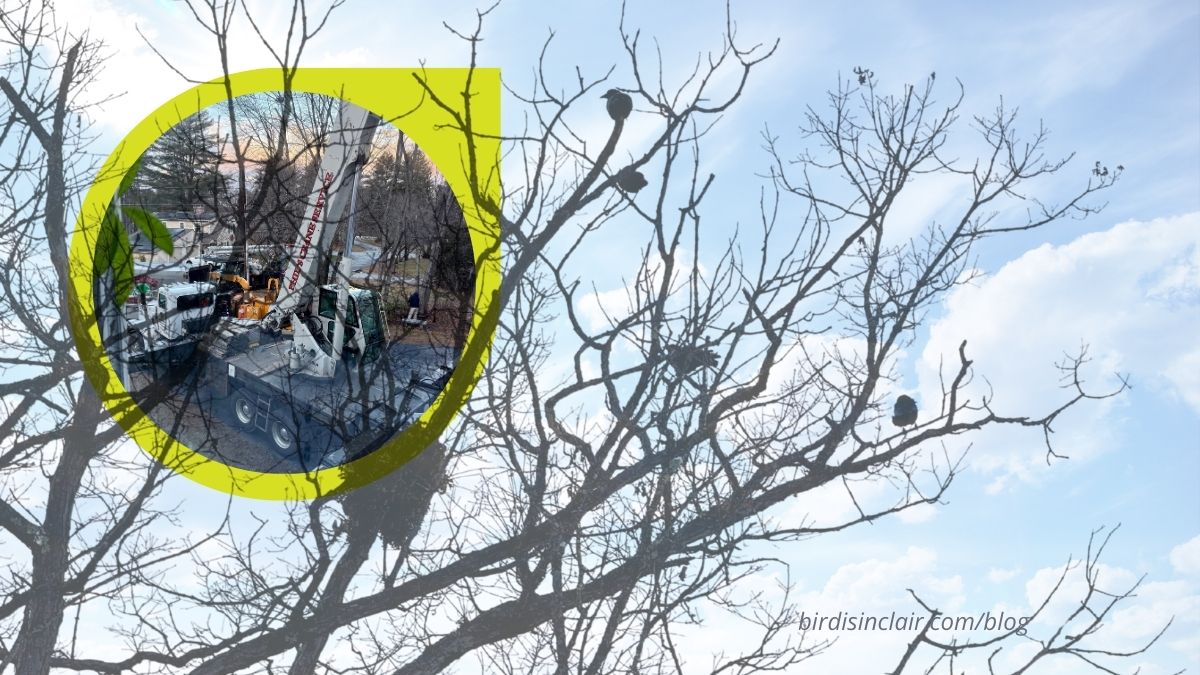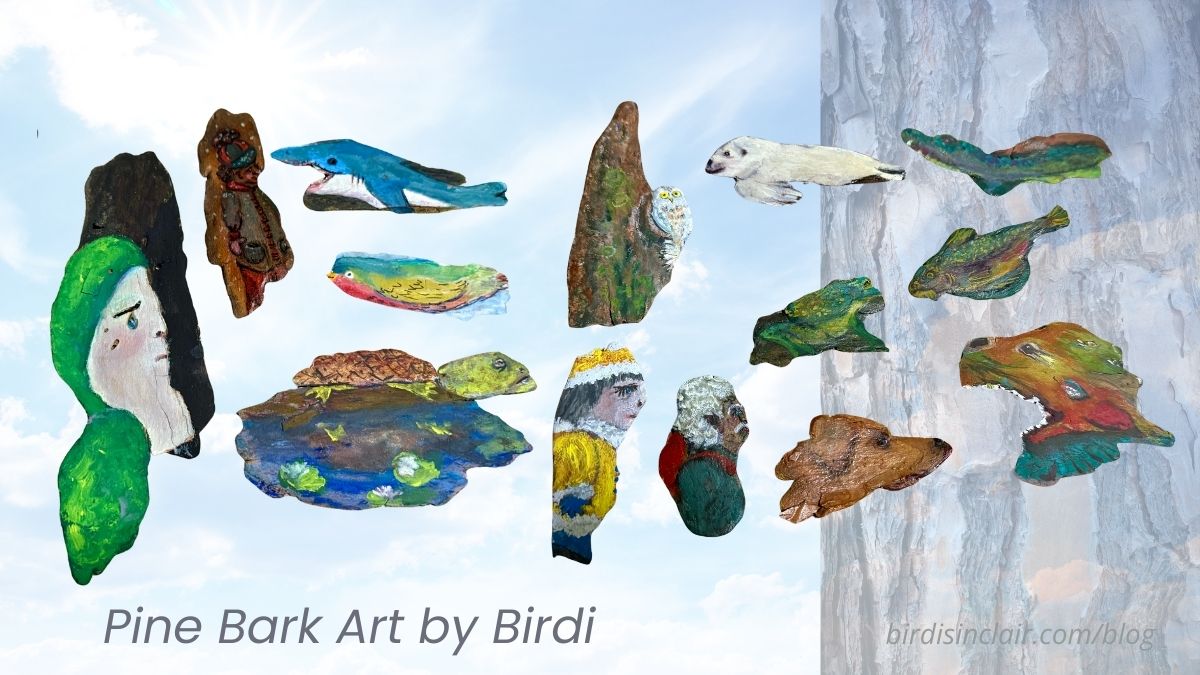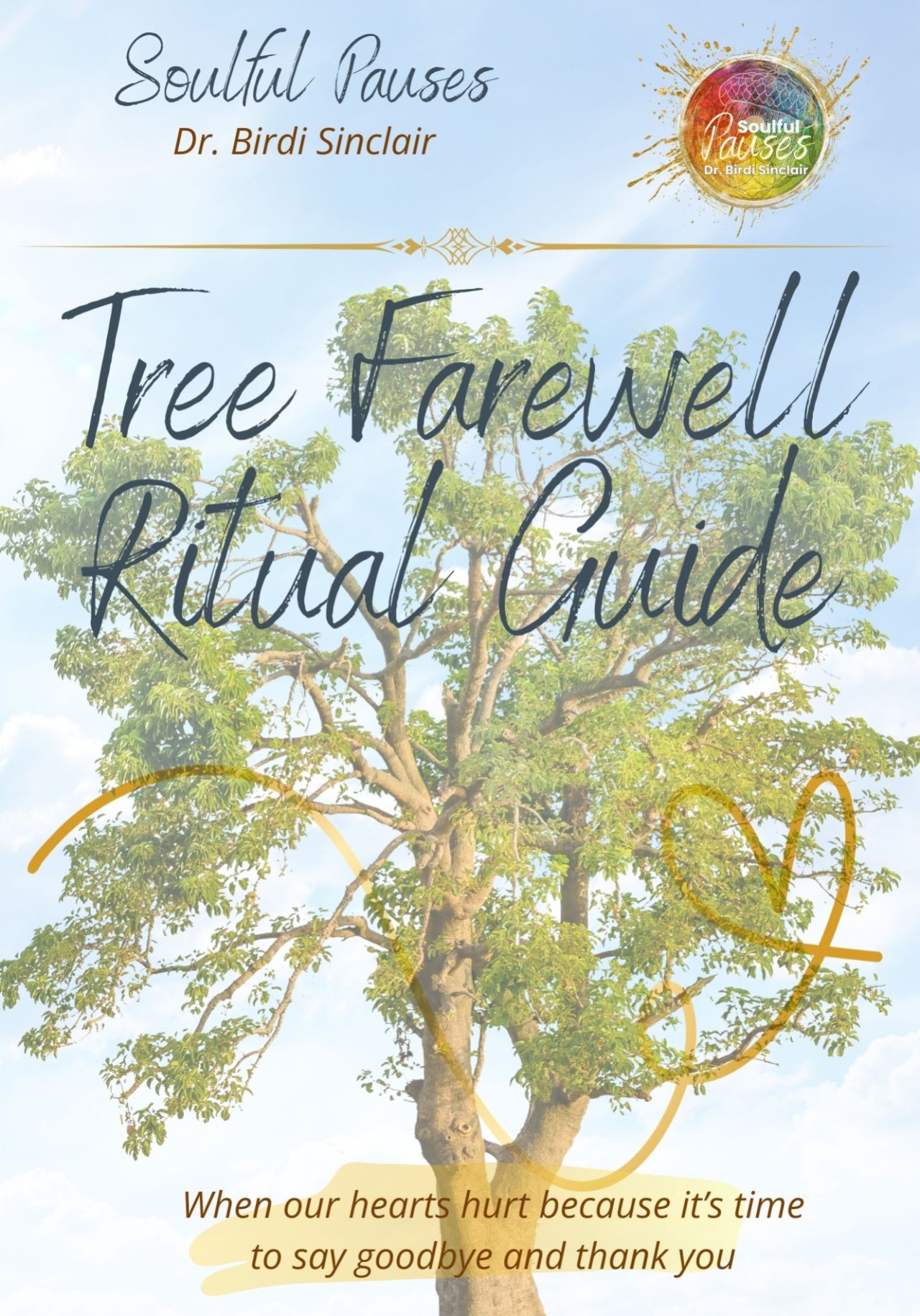
Soulful Pauses Blog
It's about connection.
The art of living whole, connected, healed, inspired.
BirdiSinclair.com/blog
Ceremony to Honor a Tree Before Removal: Rituals, Blessings & the Science of Connection

Discover how to honor a tree before removal with rituals and blessings. Explore interfaith traditions and the science of the connected lives of trees.

If you’ve googled something like “tree cutting ritual” or “ceremony to honor a tree before cutting it down,” know this: you are not alone. Many people grieve deeply when a beloved tree must be removed. That grief is love. It’s your body recognizing kinship with the living world. I also have recently experienced this loss and upset.
Ceremony gives us a way to honor that love. It’s not about performance. It’s about presence — acknowledging the tree’s life, giving thanks for its gifts, and releasing it with blessing. Together, here, we’ll explore practical and spiritual ways to create a tree cutting ritual that feels authentic, drawing from earth-based traditions, Buddhism, Hinduism, Judaism, Christianity, and modern science about how trees actually communicate.
Why Honor a Tree With Ceremony?
Human cultures have always marked transitions with ritual: births, marriages, harvests, deaths. Trees, too, have been honored across the world’s traditions as sacred: rooted in the earth, reaching for the heavens, offering shelter, wisdom, solace, inspiration, and connection.
By pausing to honor a tree before removal, you:
-
Acknowledge its life and presence.
-
Express gratitude for its gifts - shade, beauty, oxygen, habitat.
-
Process your grief rather than suppress it.
-
Release it with blessing instead of only loss.
-
Connect with the wider ecosystem of remaining trees, soil, and creatures.
Science affirms this significance that so many people through history seem to have already known. Trees are not isolated objects. They’re part of living networks.
The Science of Tree Connection
Ecologists have discovered that trees communicate through underground fungal threads - the “wood wide web.” Researcher Suzanne Simard showed that trees share nutrients, send distress signals, and even support weak neighbors. Peter Wohlleben’s The Hidden Life of Trees makes these discoveries accessible: dying trees often funnel their remaining resources into the network, nourishing others.
So when you create a ceremony to honor a tree before cutting it down, remember: the tree you are saying goodbye to is still communicating with the others nearby. Your blessing doesn’t end at its trunk. It ripples through roots and soil, carried to its kin.
Three Movements of a Tree Farewell Ritual
Across traditions, rituals often follow three movements:
-
Acknowledgment: seeing and naming the tree as a living being.
-
Gratitude: giving thanks for its gifts.
-
Release: letting go with blessing, recognizing impermanence, and planting hope for renewal.
You can keep it simple, or weave in prayers, songs, or cultural traditions that matter to you. Let’s visit how different faiths and practices approach these movements.
Spiritual and Religious Perspectives
Earth-Based Traditions
Trees are kin, elders, teachers. Ritual often includes:
-
Facing, acknowledging, welcoming the uniqueness of the four directions - North, South, East, West
-
Offering seeds, water, cornmeal, or flowers at the roots.
-
Speaking directly: “Beloved pine, thank you for shade and shelter. We release you with love.”
Ho‘oponopono (Hawaiian Reconciliation Practice)
Four healing phrases said to the tree:
-
I am sorry.
-
Please forgive me.
-
I thank you.
-
I love you.
This can be especially powerful if grief feels heavy or conflicted. I say this to myself when I pass an animal on the road, and I feel my heart hurting with some sense of sorrow, frustration, and responsibility.
Buddhism
Rituals may include:
-
Three mindful breaths.
-
A metta blessing: “May you be safe. May you be at peace. May your return to the earth benefit all beings.”
-
Chanting or humming so the blessing vibrates outward.
Hinduism
Trees are often seen as sacred dwellings of deities. Ritual might include:
-
Offering flowers, milk, or ghee at the roots.
-
Tying a sacred thread around the trunk.
-
Reciting mantras such as Om Namah Shivaya.
Judaism
Trees are honored especially during Tu BiShvat:
-
Blessings like “Baruch atah Adonai, borei peri ha-etz” (“Blessed are You, Creator of the fruit of the tree”).
-
Reading Psalm 104:16: “The trees of the Lord are well watered, the cedars of Lebanon that he planted.”
-
Planting a seedling in remembrance.
Christianity
Biblical imagery is full of trees. Rituals may include:
-
Reading Psalm 1:3: “They are like a tree planted by streams of water…”
-
Prayer: “Creator God, we thank You for this tree, for the life it sustained.”
-
Making the sign of the cross on the trunk in blessing.
Islam
The Qur’an describes trees as signs of God. A simple act like offering water or planting a sapling can be a sacred remembrance.
Secular or Humanist Approaches
Even without religious language, ritual matters. You might:
-
Speak words of thanks.
-
Save a branch slice for an art project or memory piece.
-
Take or gather past photos of the tree in each season before removal.
-
Share food or drink afterward to mark closure.

Remember the Neighbors: Remaining Trees & Creatures
Remember, your tree is not alone. The other trees will feel its absence through the underground network, in the change of lighting and wind patterns. Speak blessings for them, too:
“May you remain strong. May you continue to thrive in connection.”
And honor the creatures — the birds, squirrels, ants, fungi, owls. Scatter seeds, pour water, or set up birdhouses. A tree cutting ritual is also a creature-honoring ritual.
When we had to remove several large pine and a maple in our backyard, we took the time to remove a squirrel nest that was likely used for generations. It was in such a perfect location for their needs and the super-highway the tree provided. We built a platform with holes for drainage and escape to put the salvaged nest in so that the squirrels had a place of safety and warmth until Spring and Summer when they could start fresh.
It was very cold, and possible a squirrel was pregnant. It also gave us some small comfort when we saw they accepted our compensation. The tree guy felt duty bound to tell us they are vermin, yaddah yaddah, but his team was very competent and respectful about it.
68d2c2985f265_lg.jpg)
Everyday Actions That Add Meaning
Not every ceremony has to be formal. Small, tangible acts can make grief feel grounded:
-
Write thank-you notes to the tree and tuck them into its bark as the time approaches.
-
Make pine needle tea from fallen branches.
-
Collect pinecones or leaves to keep in your home altar.
-
Carve a piece of the wood into a bench or keepsake.
I painted some of the pine bark sheddings with the imagery I saw in the patterns - like clouds sometimes show us a wart hog or something. Another tree became a couple of very beautiful bowls. We will use some of the wood from the maple to warm us in the wood stove - and yes, I thank the lives and bodies of the trees who we use for heat. Somehow, it feels like burning wood is similar to eating meat, which I also do somewhat uncomfortably and gratefully.
These gestures turn memory into daily life.

Sample Ceremony Script
Here’s a flow you can adapt:
-
Opening: Light a candle. Pause for silence. Acknowledge land and directions.
-
Acknowledgment: Place hands on the tree. Say: “We see you. We honor you.”
-
Gratitude: Each person shares a memory or blessing. Place stones, petals, or seeds at the roots.
-
Ho‘oponopono: Speak: “I am sorry. Please forgive me. I thank you. I love you.”
-
Release: Pour water into the soil. Sing, sigh, or chant.
-
Bless Remaining Trees: Tie a ribbon to those staying. “May you thrive.”
-
Bless Creatures: Scatter seeds. “May you find shelter and peace.”
-
Commit to Renewal: Plant a seedling or pledge care to another tree.
-
Closing: Extinguish the candle. Share three deep breaths.
🌿 Quick Ritual in 5 Steps
For when you want something simple and heartfelt:
-
Touch the tree. Say hello.
-
Speak or write one thing you’re grateful for.
-
Offer water, seeds, or flower petals at the roots.
-
Say a short blessing or simply, “Thank you. I love you.”
-
Commit to planting or tending another tree in its honor.
Closing Reflection
To remove a tree is not just an act of clearing. It’s a moment of transition. Science tells us that even as one tree falls, its nutrients and signals flow outward to support others. Spiritual traditions affirm the same truth: that trees are sacred, living beings.
Creating a ceremony to honor a tree before cutting it down is an act of love. It allows you to grieve, give thanks, and release with blessing. It affirms that trees are not just wood or shade, but kin - and kin are never forgotten.
It may seem like the unnatural order of things, like you're taking a life and disrupting something precious. While this may be true in some measure, just the fact you are here, reading a blogpost like this, is a reminder that you are:
1. Not alone in feeling this way, and wanting to be as respectful as possible
2. That you have clear reasons for the decisions you have made, which weigh on you in some soul wound manner. You value the trees and their lives and did not come to this lightly.
The care you are bringing to this is the energy of spirit and place that you are bringing to their space. If you bring it with sorrow and guilt, this may be the imprint you are adding to the energetic conversation. Choose instead, to bring gratitude, humbleness, awe, and love. Let this be the message you share with these beings.
From this space, you can't get it wrong. So pick and choose what resonates most for you and create a ceremony - out loud, silently, alone, with others, whatever makes sense for you, and trust.
I've attached a mini guide with an outline of these steps in it, so you can print it, take notes in it, and have it with you. You can access it here.

In kindness, support, and shared love and sadness,
Birdi

References & Resources
-
Peter Wohlleben, The Hidden Life of Trees: What They Feel, How They Communicate (2016).
-
Suzanne Simard, Finding the Mother Tree: Discovering the Wisdom of the Forest (2021).
-
Robin Wall Kimmerer, Braiding Sweetgrass: Indigenous Wisdom, Scientific Knowledge, and the Teachings of Plants (2013).
-
Ronald L. Grimes, Deeply Into the Bone: Re-Inventing Rites of Passage (2000).
Categories: : Ceremony and Ritual, Grief and Loss, Soulful Pauses
Would you like to take the quiz I made for you?
Values, Strengths, Self-care - Oh My!
It takes a few minutes and then you get your results of your primary Core Value
based on biology, psychology, sociology, spirituality.
You'll receive a free 19 page guide! Easy, fun, thought provoking.
Like What You Read?
Subscribe to Soulful Pauses Blog
New posts will come right to you! Easy Peasy.
Thank you for sharing some time with me here.
Let's stay in touch.
Kindly,


Dr. Birdi Sinclair
Your Soulful Pauses and Intimate Living Coach
Sharing Spiritual Counseling, Direction, Coaching
Grief, Clarity, and Relationship Specialist
birdisinclair.com/support

 Dr. Birdi Sinclair
Dr. Birdi Sinclair 



